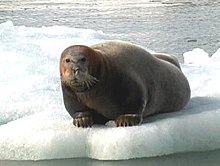Bearded seal
The other part of its Linnaean name means bearded and refers to its most characteristic feature, the conspicuous and very abundant whiskers.
[4] Distinguishing features of this earless seal include square fore flippers and thick bristles on its muzzle.
Bearded seal pups are born with a greyish-brown natal fur with scattered patches of white on the back and head.
The Inuit preferred the ringed seal for food and light; the meat would be eaten and the blubber burnt in the kudlik (stone lamp).
[12] Primarily benthic, bearded seals feed on a variety of small prey found along the ocean floor, including clams, squid, and fish.
In a study conducted during the summer months, the seals have been found to feed on invertebrates such as anemones, sea cucumbers, and polychaete worms.
[clarification needed] Pups are born on small drifting ice floes in shallow waters, usually weighing around 30–40 kg (66–88 lb).
Females ovulate at the end of their lactation period, but remain close to their pups, ready to defend them if necessary.
During the mating season, male seals will "sing", emitting a long-drawn-out warbling note that ends in a sort of moan or sigh.
[19] Like many Arctic mammals, bearded seals employ a reproductive strategy known as delayed implantation.
[23] The vocalizations produced by the bearded seal are unique, possibly because their trachea is different from that of other Northern Pacific phocids.
[24] The sounds of the bearded seal usually consist of a long oscillating trill lasting for a minute or more followed by a short, deep moan.
The repetitive and transmittable nature of bearded seal trills leads researchers to believe that they are utilized for communication, likely during courtship and breeding.
Underwater, bearded seal trills can be heard from a distance of over 30 km (19 mi), with some types of sounds traveling farther than others.
[2] This classification was determined due to various factors including, widespread distribution, stable population size, as well as alternating prey resources.
[28] Their main predators include polar bears; however, typically pups around age 2 are attacked within birthing lairs, leaving older juveniles and adults commonly unharmed.
Pinnipeds are thought to have originated 27 to 25 million years ago during the late Oligocene period.
One such study suggests that phocids are sister taxa to the common ancestor to both otariids and odobenids.


